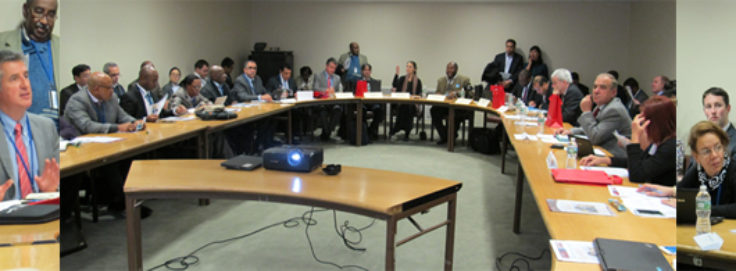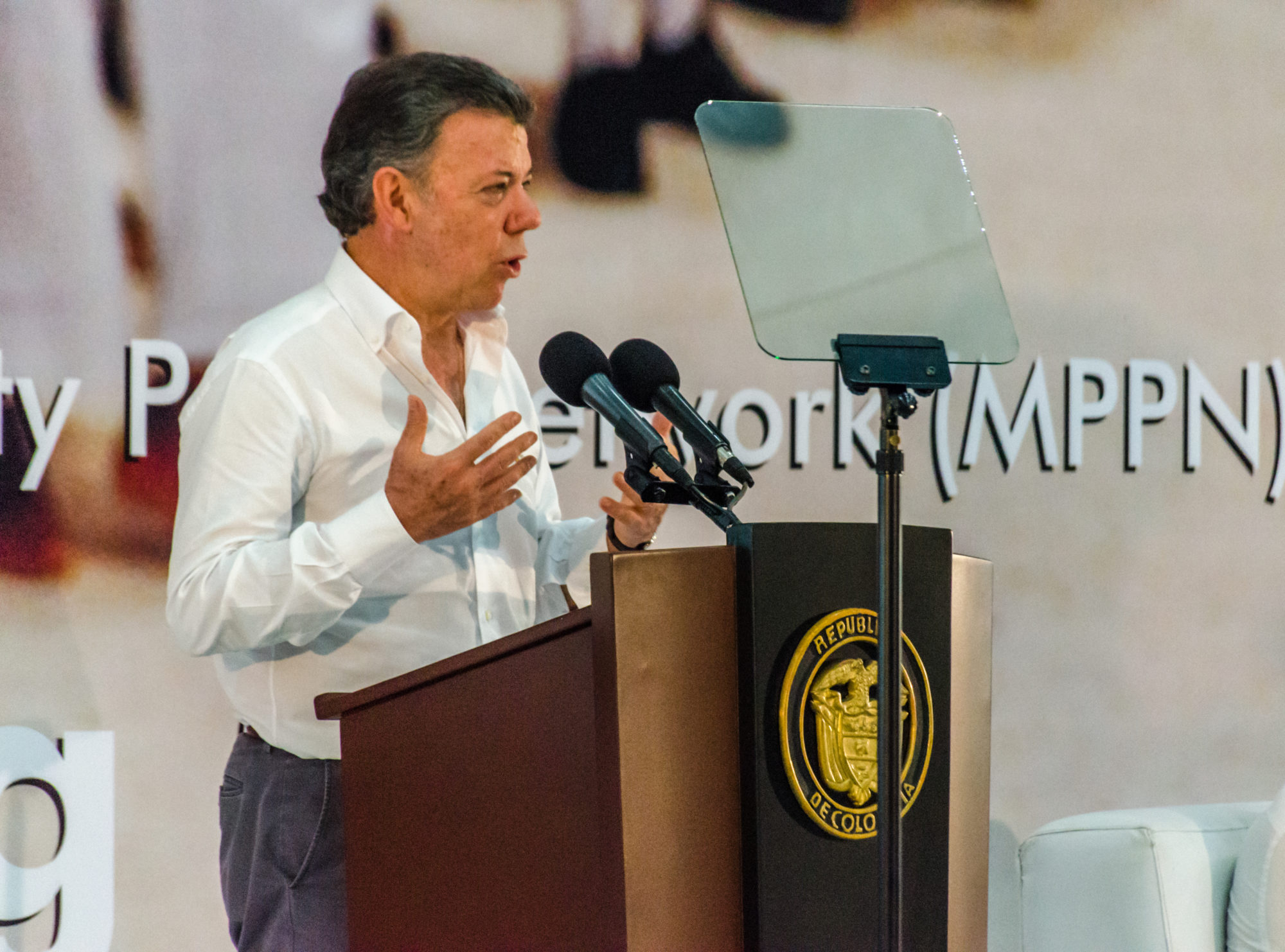
Search
2016 UNSC | OPHI and MPPN Host Side Event at UN Statistical Commission

On 7 March, 2016, OPHI and the Multidimensional Poverty Peer Network (MPPN) hosted a Side Event at the 47th session of the United Nations Statistical Commission in New York. The Commission is the key UN statistical entity, with participation from national and international statistical leaders from across the world. The very first agenda item at this session is the indicator framework to be used for measuring progress towards the Sustainable Development Goals (SDG). For Oxford Poverty and Human Development Initiative (OPHI) and the MPPN, this Side Event was a good opportunity to share countries’ experiences with multidimensional poverty measurement.
The side event brought together an overflowing room of participants, among them many leading statisticians at the forefront of innovations in poverty measurement, to discuss and share experiences with using multidimensional poverty measures for analysing poverty and as a governance tool for targeting, monitoring, and coordination of poverty reduction programmes.
Overall, the participants strongly highlighted the Multidimensional Poverty Index (MPI) as a tool that can rigorously measure poverty in all its dimensions and fulfil SDG indicator 1.2.2.

The side event was chaired by Pali Lehohla, Statistician-General for South Africa and a Steering Committee member of the MPPN. Directors of statistics from Colombia, Ecuador, Mexico, Senegal, South Africa, and Tunisia, as well as the Director of OPHI presented their ongoing work to measure and reduce multidimensional poverty. Comments from the floor were contributed by directors of statistics from Cuba, Egypt, Peru, Philippines (deputy), Morocco, and a representative from UNICEF. Participants described their multidimensional poverty indices and how these have interfaced with the policy process as tools of good governance.
Mauricio Perfetti (Colombia): Colombia’s MPI, launched in 2011, is updated annually based on 15 indicators that draw on 25 minutes’ worth of survey questions. Strong reductions in the MPI were generated by proactively designing and monitoring social public policy. Census data is used to create high-resolution poverty maps.
José Rosero (Ecuador): Launched in February 2016 by President Correa, Ecuador’s MPI measures poverty and extreme poverty annually using rights drawn from the concept of Buen Vivir. The MPI reduced by over one-third between 2009 and 2015, and will be used for policy planning. Ecuador’s National Institute of Statistics (INEC) has infographics, methods, and results online.
Julio Santaella (Mexico): Mexico released their national multidimensional measure in 2009. Mexico’s pioneering index, which is updated every two years with all statistical codes and data freely available online, provides disaggregated information and is proactively used for state and national programming and coordination.
Aboubacar Sedikh Beye (Senegal): Senegal is preparing a National MPI to support the national plan of ‘Emerging Senegal’. It will also become a centre of excellence and training in the production and dissemination of Multidimensional Poverty Statistics for Francophone Africa.
Pali Lehohla (South Africa): The South African MPI (SAMPI) uses census data from 2001 and 2011 to track reductions in the poverty rate and intensity. Job creation was a priority clearly articulated in KwaZulu-Natal, where a citizen satisfaction survey was conducted to tackle the question of matching MPI’s design to people’s values and priorities.
Hedi Saidi (Tunisia): Tunisia’s census-based MPI, which is currently being finalised, reflects the country’s post-revolutionary plan 2016-20 in which youth unemployment is a priority, and voice matters. The MPI design process engaged stakeholders in government, civil society, and academia.
Sabina Alkire (OPHI & GWU): The MPI complements dashboards by focusing on people who face several deprivations simultaneously. The headline statistic can be unpacked into clear, policy-relevant parts, becoming a useful tool for policy. The methodology is flexible and open-source, and both national and comparable MPIs add value to existing monetary poverty measures.
Insightful reflections from the floor were offered from Damar Maceo Cruz (Cuba), regarding Cuba’s MPI; AbouBakr El Gendy (Egypt) on Egypt’s trajectory of poverty analysis; Aníbal Sánchez Aguilar (Peru), on a recently-launched process to design a Peruvian MPI; Romeo S. Recide (Philippines) on their process of making the MPI a reference statistic; Belkacem Abdous (Morocco), on their work linking multidimensional poverty and human development; and Martin Evans (UNICEF), on a child poverty measure that is linked to the MPI.
—
Presentations from the Side Event (all pdf):
- Mauricio Perfetti, Director, Administrative Department of National Statistics, Colombia
- José Rosero, Executive Director, National Institute of Statistics and Census, Ecuador
- Aboubacar Sedikh Beye, Director General, National Agency for Statistics and Demography, Senegal
- Pali Lehohla, Statistician-General, Statistics South Africa, South Africa
- Sabina Alkire, Director, Oxford Poverty and Human Development Initiative, University of Oxford, and Oliver T. Carr Jr. Professor and Professor of Economics and International Affairs, George Washington University
- Belkacem Abdous, Director of Statistics, High Commission for Planning, Morocco (speaking points)
— — — — — — — —
About National and Global MPIs:
Governments such as Mexico, Colombia, Bhutan, Chile, Costa Rica, El Salvador, Ecuador, and Ho Chi Minh City, Vietnam use official multidimensional poverty indices (MPIs), to measure SDG 1.2. Each national MPI is tailor-made to the national context. For example, its design may reflect the constitution, or national development plan, or a participatory exploration of what poverty means. The national MPI may be computed using the same survey as income poverty metrics, or a different survey. It may be updated annually or every 2 years. Each national MPI is an official poverty statistic, but an effort is made so that it is used to inform and energise policy.
Yet not all governments have national MPIs. Even when they do, national MPIs cannot be compared. So there is a value-added to having a comparable global MPI across developing countries and/or universally, with extensive and disaggregated information on the composition of poverty for different groups. A global MPI for developing countries has been estimated by OPHI and the UNDP’s Human Development Report Office, and disaggregated for 1,300 subnational regions, as well as by variables like age and rural-urban areas. The global MPI might be particularly useful for SDG target 1.2 of halving multidimensional poverty, and potentially by countries without tailor-made National MPIs at the present time.
About the Multidimensional Poverty Peer Network (MPPN):
This event was co-hosted by the Multidimensional Poverty Peer Network (MPPN), a group of senior representatives from over 40 governments and international institutions, and its Secretariat, OPHI.
The Multidimensional Poverty Peer Network was launched in June 2013 at a distinguished event at the University of Oxford, at which President Juan Manuel Santos of Colombia and Professor Amartya Sen gave keynote addresses. The network was established in response to the overwhelming demand for information on implementing multidimensional measures, and for technical and institutional support. The Network Steering Committee includes Ministers and senior government officials from China, South Africa, Mexico and Colombia as well as from OPHI.
Participants in the MPPN include Ministers and senior officials from over 40 governments and international agencies.
| Afghanistan | Costa Rica | India | Nigeria | Seychelles |
| Antigua and Barbuda | Cuba | Iraq | Pakistan | South Africa |
| Angola | Djibouti | Malaysia | Paraguay | Sudan |
| Bhutan | Dominican Rep. | Mexico | Peru | Tajikistan |
| Brazil | Ecuador | Mongolia | Philippines | Tunisia |
| Chile | El Salvador | Morocco | Saint Lucia | Turkey |
| China | Grenada | Mozambique | Saint Vincent | Uruguay |
| Colombia | Honduras | Nepal | Senegal | Vietnam |
Other international institutions that participate in the MPPN include BMZ (Government of Germany), the United Nations Economic Commission for Latin America (ECLAC), the Islamic Development Bank (IDB), the Organisation for Economic Co-operation and Development (OECD), the Organization of American States (OAS), the Organization of Eastern Caribbean States (OECS), the Southern African Development Community (SADC), the Statistical, Economic and Social Research and Training Centre for Islamic Countries (SESRIC), and OPHI.
















